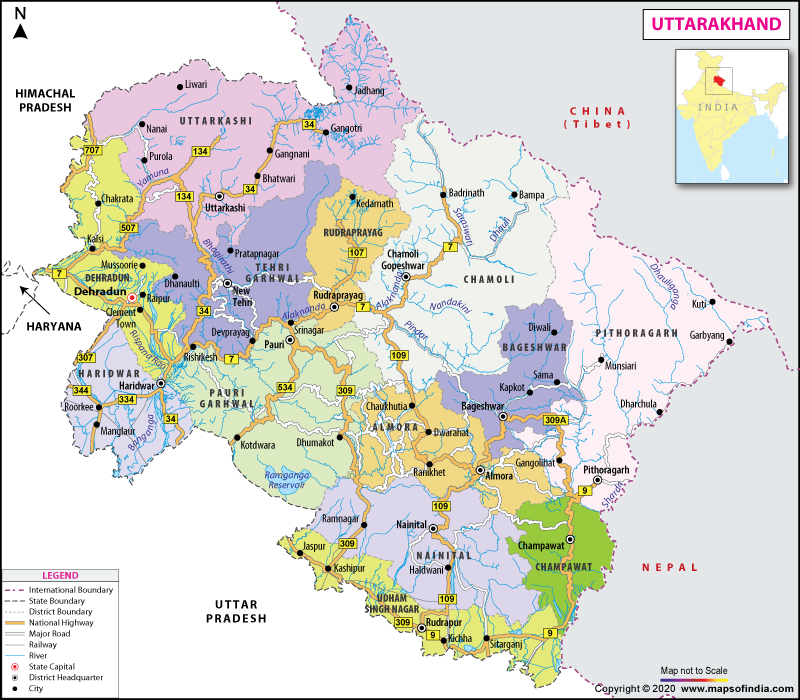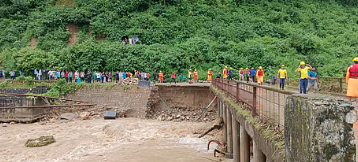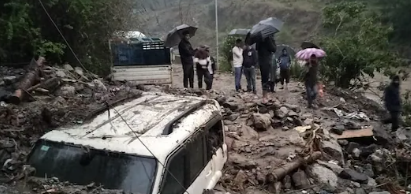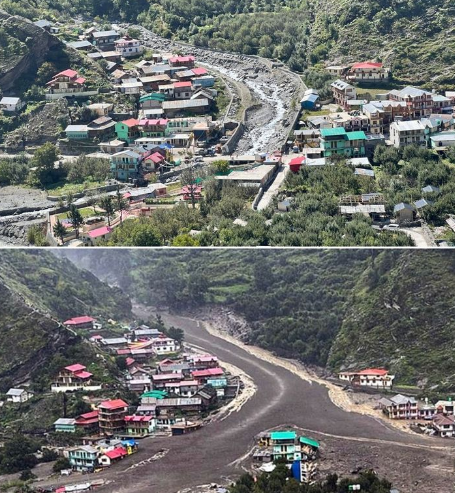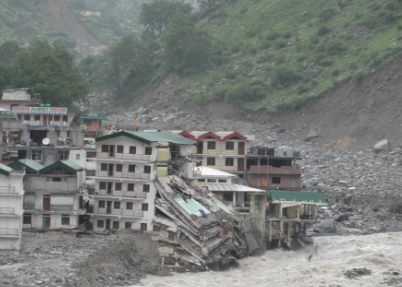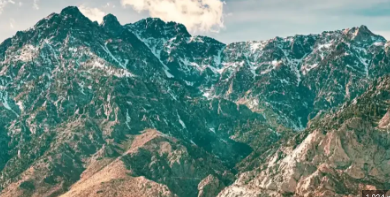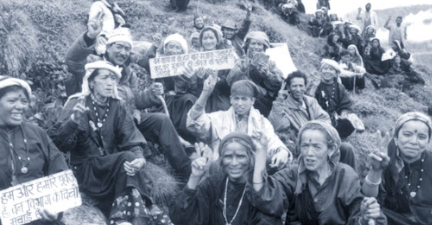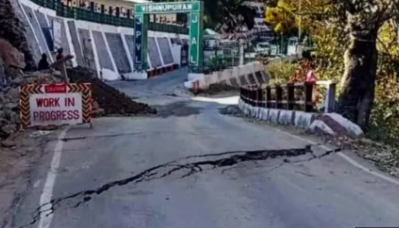
Dehradun Cloud Burst and the increasing cases of Natural Disasters in Uttarakhand
“माता भूमि: पुत्रोऽहं पृथिव्याः”
(Mātā bhūmiḥ putro’ham pṛthivyāḥ)
Translation: Earth is my mother, and I am her son.
Source: Atharva Veda (12.1.12)
Introduction
The beautiful Himalayan state named Uttarakhand, formed in the year 2000 and it is often called the “Devbhumi,” or “land of the Gods“. In recent times, Uttarakhand is in news not because of its culture, traditions or mother Ganga but for the frequent natural disasters. State tragedies such as flash floods, landslides or land subsidence have occurred in the state of young mountains. Indian Standpoint, in this article will discuss the recent Uttarakhand landslides and cloudbursts with detailed analysis.
On 16th, September 2025, we all saw the dangerous Dehradun District Floods, brought on by a sudden storm cloudburst in the area, which once again showed us that Himalayan Region is becoming more vulnerable. The State Emergency Operation Centre reports that the state is struggling with many catastrophes each year. There are many cases of flash flooding, landslides, and heavy rainfall causing dramatic impact on the geography and the geology of the state. While the Himalayas is a young, unstable mountain range, the unchecked growth of urbanization in the region, coupled with climate change and not well planned infrastructure development, has increased the severity and frequency of these natural disasters in Uttarakhand.
Recent Natural Disaster Cases in Uttarakhand
-
- Dehradun district floods (September 2025)
The severe rains and cloudbursts impacted almost the whole Doon valley, especially the area of Dehradun. Times of India reported about the killing of at least 13 people and missing 16 people. Across Uttarakhand and neighboring state of Himachal, the death toll is expected to increase to 18. This natural calamity damaged infrastructure and life of the people in the region. Local people suffered from climate change in Uttarakhand, Himalayas. - Sahastradhara Region, Dehradun
In September 2025, we all saw the villages in the Sahastradhara area were hit by landslides and floods after heavy rains. Agricultural land was buried under rubble and debris of the landslides. The entire paddy fields were destroyed and homes wrecked. Some villagers lost livestock and their crops, hitting them economically. Recovery is expected to be slow, especially where land is now covered with boulders, reported by Times of India. - Tapkeshwar Mahadev Temple, Dehradun
This place is a historic and well known religious and tourist site known for its historical connection with Mahabharata and Dronacharya, saw its courtyard and surroundings flooded after a cloudburst. While the inner sanctum remained safe, it shows the vulnerability of these religious sites as well. - Mussoorie Heavy Rain & Landslides
Nav bharat times reported that during the same time, Mussoorie also suffered serious landslides and road blockages. A Bailey bridge was damaged; stranded visitors and locals had to be rescued. In one incident, 12 people critically ill were successfully rescued during the chaos. - Dharali Village, Uttarkashi
Times of India reported a massive cloudburst nearly submerged part of Dharali. Homes, hotels, and shops were swept away. Interestingly, Dharali lies on the route to the Gangotri pilgrimage and there were houses and markets built on the river bed. Many tourists and locals were stranded in this flash flood. The flood destroyed infrastructure, damaged livestock, and made large areas inaccessible. Some sources claim the whole village is flashed out. Rescue operations involved SDRF, Army teams, using heavy machinery and search dogs.Monsoon rains in 2025 – Multiple districts
- Dehradun district floods (September 2025)
Since June 2025 heavy rainfalls have caused 21 deaths, 11 injuries, and 9 people missing (in Uttarkashi). Uttarkashi and Chamoli are the most affected districts. Rudraprayag and Dehradun were also severely affected. Multiple alerts have been issued by the government. The roads are closed, there are dozens of homes that have been destroyed or damaged in part.
- Power & Infrastructure loss in Dharali-Tharali Region
Recent floods and landslides have severely damaged the electricity infrastructure. Over 300 villages were affected by the destruction of 228 poles and 37 km of lines in Tharali. Dharali lost 14 km line and 84 poles, affecting electricity in nine villages. Transformers and transmission lines have been washed out. A local government survey reports this information. - Environmental & Wildlife Losses
The wildlife in the region got affected by extreme weather conditions. In the floods that recently occurred in Uttarkashi, there are visuals of animals suffering from this calamity including the leopard struggling in flood water. There are reports of loss of forest cover and habitat, as well as blocked migration routes.
The above mentioned recent cases of natural disasters in Uttarakhand just show the glimpse of the major impact our nature is facing. Now, it goes far beyond the immediate destruction and loss of homes. These losses affect agriculture, livestock, even religious and heritage sites which are integral part of the native people of Devbhoomi. Another challenge these calamities make is the loss of infrastructure as they cut off access to services such as markets, hospitals and relief aid. The displacement of families from riverbank settlements, narrow valleys and other areas is also a critical issue. Many families are forced to abandon their homes as well as livelihoods. Uttarakhand is the land of culture and religion which is also impacted by the vulnerability of the natural disasters in Uttarakhand.
Annual Disaster Frequency in Uttarakhand: Recent/ New Data from Uttarakhand
Disaster Frequency in Uttarakhand
- It is noted that in between 2015 and 2024, Uttarakhand recorded 18,464 disaster incidents in total, including floods, landslides, cloudbursts, storms, and more. Indian Express reported that there are an average of over 2,000 incidents every year.
- Heavy rainfall and flash floods alone made up 12,758 incidents in this period. Landslides accounted for over 4,000 incidents, while cloudbursts were recorded 67 times.
Recent Data of Natural Disasters in Uttarakhand
- New Indian Express reported, In the monsoon of 2024, Uttarakhand experienced 1,813 landslides, nearly double compared to earlier years.
- Whereas, Worldys News reported that by comparison in 2023 it recorded over 1,100 landslides, in 2022 had 245 and in 2021 had 354.
- The number of deaths also increase due to these calamities, such as:
• Times of India reported, 316 people have died in landslides between 2015 and 2024.
• Indian Express News reported that in 2024 alone, around 82 lives were lost due to landslides and flash floods.
Geographical and Seasonal Concentration
- Certain districts are consistently more vulnerable to these natural calamities such as Pithoragarh, Rudraprayag, Tehri, and Uttarkashi. Times of India reported that these districts experienced the highest numbers of landslide and flood-related fatalities.
- It is naturally observed that most of these disasters occur during the monsoon months, June to September, when rainfall intensity is highest.
Long-Term Trends
- Down to Earth quoted data from ISRO’s Landslide Atlas shows that between 1988 and 2022, Uttarakhand experienced 11,219 landslides, making it the second-highest state in India after Mizoram.
- Prevention Web reports that the state has shifted from recording a few hundred landslides annually to more than a thousand in a single monsoon.
Key Takeaways from the Numbers
Uttarakhand experiences an increasing number of natural disasters. Landslides are of particular concern in the region. Both human fatalities and infrastructure damages are increasing. With each monsoon, there is a significant loss of non-living as well living objects. Despite this, there are certain areas that suffer more than others because of the steep hills, valleys along rivers, or overcrowded and vulnerable places. It is even more alarming that these catastrophes are clustered by monsoon season.
Causes of Natural Disasters in Uttarakhand
1. Fragile Himalayan Geology
- The Himalayas are the youngest mountain range in the world, still rising due to tectonic activity between the Indian and Eurasian plates. This makes their rock structure weak and unstable, highly prone to landslides and erosion.
- Reports of the Geological Survey of India show that Geologists noted, nearly 70% of Uttarakhand’s terrain is landslide-prone, especially areas along steep slopes and river valleys.
- Frequent micro-seismic activities in the Garhwal and Kumaon regions loosen soil and rock, making them vulnerable to collapse during heavy rainfall or earthquakes.
2. Recent Extreme Monsoon Rainfall & Cloudbursts
- Uttarakhand’s steep topography funnels monsoon rains into narrow valleys, causing flash floods and cloudbursts.
- On average, the state records 2 – 3 major cloudbursts every monsoon season, but recent years have seen an increase. For instance, in 2024 alone, multiple cloudbursts struck Dehradun, Rudraprayag, and Uttarkashi.
- Rising global temperatures are increasing the water-holding capacity of the atmosphere, making rainfall events more intense. This is why single-night cloudbursts can release over 100 mm of rainfall in just an hour, overwhelming rivers and drains.
3. Glacial Melt and Formation of Glacial Lakes
- Wadia Institute of Himalayan Geology reported, Uttarakhand has 1,439 glaciers, many of which are retreating rapidly due to climate change.
- Melting glaciers form unstable glacial lakes, which can burst suddenly (Glacial Lake Outburst Floods – GLOFs).
- The Chamoli disaster in February 2021 was linked to a massive rock and ice avalanche that released huge amounts of water, devastating hydropower projects and killing over 200 people.
4. Deforestation and Loss of Natural Buffers
- Forests cover about 45% of Uttarakhand, but rapid clearing for roads, urbanization, and tourism projects is reducing this natural protection.
- Trees stabilize soil and absorb rainwater but the removal of trees increases runoff, erosion, and landslides.
- According to the Forest Survey of India, Uttarakhand lost 268 sq km of forest cover between 2015 and 2023, much of it in landslide-prone districts like Chamoli and Pithoragarh.
5. Unplanned Urbanization & Tourism Pressure
- Devbhoomi is considered as a major pilgrimage and tourist hub, with places like Kedarnath, Badrinath, Gangotri, Yamunotri, and Mussoorie welcoming millions of visitors every year.
- Towns such as Joshimath and Munsiyari have expanded without proper geo-technical studies, leading to land subsidence. The Joshimath sinking crisis in 2023 saw over 600 houses develop cracks due to uncontrolled construction and tunneling projects. Now scholars are observing the Joshimath sinking case study.
- Hotels, roads, and homestays are often built on fragile slopes without adequate drainage or retaining structures, worsening landslide risks.
6. Hydropower and Road Projects
- Uttarakhand has over 100 hydropower projects (commissioned, under construction, or proposed), many located on fragile riverbanks.
- Blasting, tunneling, and diverting rivers destabilize slopes and increase disaster vulnerability. The Tapovan-Vishnugad hydropower plant was destroyed in the 2021 Chamoli flood, raising questions about the wisdom of such projects in fragile zones.
- The Char Dham Highway Project, involving massive hill cutting and slope excavation, has triggered frequent landslides along the routes to Kedarnath, Badrinath, Gangotri, and Yamunotri. Char Dham highway environmental impact is important but needs sustainable options.
7. Climate Change & Global Warming
- IMD data reported that average temperatures in Uttarakhand have risen by nearly 0.7°C over the past century, leading to torrential rainfall and faster glacier retreat.
- Rising temperatures also destabilize permafrost in higher Himalayas, making slopes more prone to avalanches and rockfalls.
- The Inter-governmental Panel on Climate Change (IPCC) has warned that the Himalayas are warming at twice the global average, amplifying risks of extreme rainfall, glacier melt, and floods.
8. Soil Erosion & Riverbank Encroachment
- Construction along rivers like the Alaknanda, Bhagirathi, and Mandakini narrows their natural channels.
- When sudden floods come, the lack of floodplains causes rivers to overflow into towns and villages.
- Heavy siltation from soil erosion further raises riverbeds, reducing their water-holding capacity and worsening flood risk.
Historical Movements to Protect Environment in Uttarakhand
1. Chipko Movement (1970s)
- It originated in Chamoli district (then part of Uttar Pradesh, now Uttarakhand).
- Villagers, led by activists like Sundarlal Bahuguna and Gaura Devi, hugged trees to prevent contractors from cutting them down.
- It became a global symbol of community-driven forest protection.
- The impact of this movement was to make the government ban the felling of trees in the Himalayan regions for 15 years in 1980.
2. Anti-Tehri Dam Movement (1980s–2000s)
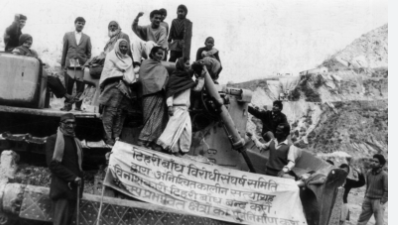
- Activists opposed the construction of the Tehri Dam on the Bhagirathi River, citing seismic vulnerability and displacement of people.
- Although the dam was eventually built, the movement highlighted the ecological and human costs of large dams in fragile Himalayan terrain.
- Leaders like Sundarlal Bahuguna went on long fasts to oppose it, bringing international attention to Himalayan ecology.
3. Nanda Devi Biosphere Resistance (1980s)
- In the higher Himalayas, villagers opposed excessive tourism and mountaineering expeditions near Nanda Devi National Park, which caused environmental degradation.
- Local communities demanded regulated eco-tourism and better safeguards for sacred peaks and fragile ecosystems.
Initiatives taken on Grassroots Level
1. Beej Bachao Andolan
- Started in the late 1980s by farmers and activists in Tehri and Uttarkashi.
- Focused on preserving traditional seed varieties and organic farming to reduce reliance on chemical fertilizers that damage soil and water.
- This movement also promoted sustainable farming, protecting against land degradation.
2. Mahila Mangal Dals
- Local women-led groups active across villages in Uttarakhand.
- They play a big role in forest protection, anti-deforestation campaigns, and disaster relief efforts.
- Their activism builds on the spirit of the Chipko Movement, but focuses on day-to-day forest and water management.
Initiatives by Modern Government and Institutions
1. State Disaster Management Authority (USDMA)
- Established after the Kedarnath disaster of 2013.
- Works on early warning systems, disaster preparedness, and public awareness campaigns.
- Runs training programs in vulnerable districts on earthquake and landslide safety.
2. Declarations of Eco-Sensitive Zone
- Several fragile zones, including parts of the Bhagirathi valley and around Nanda Devi National Park, have been declared Eco-Sensitive Zones.
- These restrict large-scale industrial and construction activities, aiming to balance development with ecology.
3. Ban on Plastic in the Char Dham Yatra Routes
- Introduced in recent years to reduce waste and pollution during pilgrimage seasons.
- Eco-task forces and NGOs patrol areas to prevent dumping of non-biodegradable waste.
4. Catchment Area Treatment (CAT) Plans
- Hydropower and road projects are now required to fund soil stabilization and afforestation programs in catchment areas to reduce erosion.
- Though implementation is mixed, this marks an attempt to minimize ecological costs of development.
5. Disaster Mitigation Research Centres
- Institutions like the Wadia Institute of Himalayan Geology (WIHG) and GB Pant Institute of Himalayan Environment are actively monitoring glaciers, rivers, and landslide-prone zones.
- Their research supports early warning systems and risk assessment maps.
Recent Protests and Movements Led by Locals
- Joshimath Land Subsidence Protests (2023): Residents staged sit-ins and marches demanding accountability for unregulated construction and tunneling projects linked to NTPC’s hydropower development. Their activism forced authorities to declare Joshimath a “sinking town” and relocate many families.
- Save Bhagirathi Movement (Ongoing): Environmentalists are campaigning for stricter regulations on hydropower projects in the Bhagirathi river basin, citing risks of floods and landslides.
Importance of these Protests
Local communities in Uttarakhand recognize risks earlier than planners and engineers. They draw attention to vulnerabilities which might otherwise be overlooked. They emphasize sustainability, traditional wisdom, and public participation as essential tools for preventing disasters. The history of the state itself shows the importance of grassroots activism. Most notably, the Chipko Movement which was responsible for the protection and conservation of forests in India. Native people of Uttarakhand are vulnerable to these disasters and they understand the geology of their mother land.
Uttarakhand: Need of Sustainable Development in Himalaya States
1. Eco-Sensitive Development Planning
- All major infrastructure projects either roads, dams or hotels should undergo rigorous environmental impact assessments (EIA), focusing on landslide risk, seismic vulnerability, and drainage systems.
- There should be some limit on heavy blasting, tunneling, and slope cutting for projects like highways and hydropower. Instead, encourage tunnel-boring technology and smaller, eco-friendly projects.
2. Sustainable Tourism Models
- Instead of mass tourism, the government should encourage regulated eco-tourism with caps on daily visitors.
- Promote homestays, village tourism, and off-season travel to distribute pressure among different parts of the region.
- Example: Bhutan’s “High Value, Low Impact Tourism” policy could inspire Uttarakhand to balance tourism with ecological safety.
3. Smart Hydropower & Energy Alternatives
- Replace large hydro dams with run-of-the-river projects, which do not require massive reservoirs or slope blasting.
- Invest in solar and wind energy farms in foothill areas to reduce dependence on destructive hydro projects.
- We can take inspiration from Nepal because they successfully piloted small hydro and solar hybrids in mountain villages. India is a huge nation, so we can do it more easily.
4. Urban Planning with Land Zoning
- Towns like Joshimath and Mussoorie need strict land use regulation. No construction on landslide-prone slopes or river floodplains.
- Expand use of remote sensing and GIS mapping to mark vulnerable zones where construction is banned.
- Japan enforces strict “no-build zones” in landslide-prone mountainous terrain. So we can utilise this initiative in this town.
5. Reforestation & Ecosystem Restoration
- Launch mass afforestation drives with native Himalayan species like oak and rhododendron, which stabilize slopes better than pine.
- Involve local communities through eco-task forces and women’s groups. It can generate employment as well for the locals.
- Restore natural wetlands and floodplains that act as water buffers.
6. Disaster Preparedness & Early Warning Systems
- Install automated rainfall and river monitoring systems in all flood-prone districts.
- Use satellite-based landslide forecasting models like we can use ISRO’s Landslide Atlas for real-time alerts.
- We can train local communities in disaster drills, evacuation planning, and local relief management.
7. Glacier & Climate Risk Management
- Monitor shrinking glaciers and potential GLOFs (Glacial Lake Outburst Floods) with satellite imaging.
- Create controlled drainage channels for unstable glacial lakes.
- Bhutan drained Thorthormi Lake in the Himalayas to reduce GLOF risk and we can also follow this model in Uttarakhand for lakes like Chorabari.
8. Sustainable Agriculture & Livelihoods
- Promote terrace farming with soil conservation techniques to reduce erosion.
- Encourage organic farming and traditional seed preservation movements.
- Less or no use of pesticides that can reduce fertility of the soil. We can inculcate the knowledge of millets in local communities.
9. Community-Led Conservation
- Empower Gram Sabhas (village councils) to manage local forests, springs, and grazing lands under the Forest Rights Act.
- Strengthen grassroots women’s groups and youth organizations for monitoring illegal tree felling, sand mining, and construction.
- The Chipko Movement is the best example of it that showed how community vigilance can succeed where top-down governance fails.
10. Army & Strategic Development with Ecology
- Since Uttarakhand is a border state, large Army infrastructure is essential to provide best support to our soldiers and authorities.
- We can adopt eco-sensitive army housing, tunnels, and logistics planning to minimize slope cutting while maintaining developmental programs.
- The Indian Army’s Eco-Task Forces in Kumaon and Garhwal are already reforesting degraded slopes and this initiative is unique in itself and we can expand it.
Global Inspirations for Uttarakhand’s Sustainable Development
1. Switzerland: Balancing Tourism & Alpine Ecology
- Switzerland has one of the world’s strongest zoning laws: construction in avalanche or landslide-prone areas is banned.
- Tourism is high-end but low-impact, instead of allowing uncontrolled mass tourism, they focus on quality tourism with regulated visitor numbers.
- Railways, cable cars, and tunnels are built using advanced engineering with minimal slope cutting, protecting fragile mountains.
- In Uttarakhand we can use regularised tourism policy and invest in safe tunnels and ropeways instead of widening mountain roads.
2. Bhutan: The “High Value, Low Impact” Model
- Bhutan limits the number of tourists through a daily sustainable development fee to reduce overcrowding.
- Its development philosophy of Gross National Happiness (GNH) emphasizes environmental conservation, cultural preservation, and community well-being over GDP growth.
- Hydropower is developed cautiously and much revenue is invested in forest protection (72% of Bhutan is under forest cover).
- In Uttarakhand we can regularise the mountain tourism and link tourism earnings to local community welfare and reforestation.
3. Japan: Disaster Preparedness & Early Warning Systems
- Japan has mastered earthquake-resistant construction, landslide monitoring, and community-level disaster drills.
- Landslide-prone regions are fitted with real-time monitoring sensors connected to village sirens and mobile alerts.
- Community training ensures that people know how to respond within seconds to disasters.
- In Uttarakhand we can iInstall real-time landslide, flood, and GLOF (glacial lake outburst flood) warning systems, and train locals in evacuation drills.
4. New Zealand: Indigenous Knowledge & Eco-Tourism
- New Zealand integrates Māori indigenous wisdom with modern policies to protect rivers, forests, and mountains.
- Adventure tourism is heavily regulated to ensure safety and sustainability.
- Forests and rivers are given legal rights as living entities, ensuring stricter protection.
- In Uttarakhand, we can also take this initiative to treat rivers as living entities and provide them legal rights. We can use the local knowledge of people in scientific studies to train others from base about their local geology.
5. Costa Rica: Payment for Ecosystem Services (PES)
- Farmers and villagers are paid by the government to conserve forests and protect water sources.
- Eco-tourism is a major revenue source, and income goes back into community development.
- Forest cover increased from 21% in 1987 to over 50% today due to these policies.
- In Uttarakhand we can also introduce these initiatives where locals are rewarded for protecting forests, springs, and biodiversity. Apart from it we can take guidance from them.
6. Norway: Hydropower with Ecology
- Norway runs almost entirely on hydropower but follows strict ecological rules, small plants, fish ladders, and minimal disruption to rivers.
- Large reservoirs are rare; instead, distributed mini-hydro projects provide local power.
- In Uttarakhand, we can also work on mini-hydro projects instead of big projects.
Key Recommendations for Government (State & National Level)
1. Implement Strict Land-Use Zoning
- The Ravi Chopra Committee formed after the 2013 Kedarnath disaster, strongly recommended that construction should be banned in high-risk eco-sensitive zones above 2,200 meters. Indian Standpoint believes that development is the most important part of any society but it needs to be sustainable, so banning construction is not a solution but we need to regularise it and make some creative alternative solutions to the problem.
- The government should ban any construction in the riverbeds, steep slopes, and landslide-prone areas.
2. Regulate Tourism
- During the Char Dham Yatra most pilgrims visit the Devbhoomi, we can regularise it and set the number of people visiting in a single day. We can divert the masses equally in different sites.
- We can follow the carry capacity approach, in which we are going to allow a number of people as per the capacity of the region.
3. Eco-tourism and forest conservation in Uttarakhand
- We can promote Eco-tourism in the region by promoting more eco tunnels and light railways lines. We need to work on a reforestation drive as well.
- We can take inspiration from foreign models or make something new that can inspire foreign nations.
4. Hydropower Projects – Strict Review
- Recommendation from environmentalists & NGT: Instead of sanctioning large hydropower dams in fragile zones, we can work on alternatives like mini-hydro plants.
- Promote small, run-of-the-river projects that don’t destabilize mountains.
5. Strengthen Early Warning & Monitoring Systems
- Install real-time monitoring systems for landslides, glacial lake outburst floods (GLOFs), and cloudbursts.
- Expand ISRO’s Landslide Atlas into a community-level alert system, linked with mobile alerts and local sirens.
6. Protect Forests & Springs through Local Participation
- Launch a Himalayan Payment for Ecosystem Services Program where locals are rewarded to conserve forests, water springs, and biodiversity. This initiative can be open for other state tourists as well.
- Recognize Van Panchayats (village forest councils) as official partners in climate related issues.
7. Scientific Urban Planning
- Stop unregulated urban expansion in Dehradun, Haridwar, Rishikesh, and hill towns like Joshimath and Mussoorie.
- Promote vertical eco-housing instead of horizontal sprawl, and enforce earthquake-resistant building codes.
8. Independent Environmental Audits
- Regular audits of projects like Char Dham Highway, hydropower plants, and town planning should be done by independent scientific bodies.
- Implement “Environmental Report Cards” for every project.
9. Disaster-Resilient Livelihoods
- Encourage eco-tourism, organic farming, herbal industries, and handicrafts that depend less on big constructions.
- Provide training and subsidies to locals to shift from exploitative to climate-friendly livelihoods.
10. National-Level Framework for the Himalayas
- Experts including the NITI Aayog have suggested creating a “Himalayan Policy” that covers all Himalayan states such as J&K, Himachal, Uttarakhand, Sikkim, Arunachal, etc.
- This would ensure uniform guidelines on construction, tourism, hydropower, and disaster management.
Conclusion
Kedarnath flood 2013 impact at large scale on human lives but what we understand from that natural disaster, are we prepared for other calamities? Natural disasters in Uttarakhand are increasing and the recent dehradun district flood is again a knock on the doors of our decision makers to make disaster management solutions for Uttarakhand.
The Himalayan mountains are not just peaks of stone; they are the mukuṭ of Bharat, the crown of India, guarding our rivers, our climate, and our culture. Uttarakhand, the heart of these ranges that we call devbhoomi with pride, is a sacred land where ecology and spirituality meet. But every landslide, every flood, every sinking town is a warning that careless growth can impact this crown.
The path forward is clear, development must walk hand in hand with sustainability. Indian Standpoint believes in development but development should not impact our impact. Roads, power projects, and tourism should strengthen local communities and our nation without wounding the mountains. Protecting the Himalayas is not an option but it is our duty and responsibility to the generations yet to come.
“पृथ्वीं धारयमाणोऽहमन्नादोऽस्मि पृथिव्या धारयामि”
(Pṛthvīṁ dhārayamāṇo’ham annādo’smi pṛthivyā dhārayāmi)
Translation: The Earth holds me, I nourish myself from her, and in turn, I must hold and protect her.
Source: Atharva Veda, Bhumi Sukta
